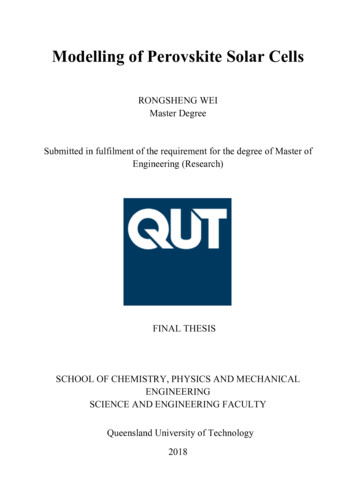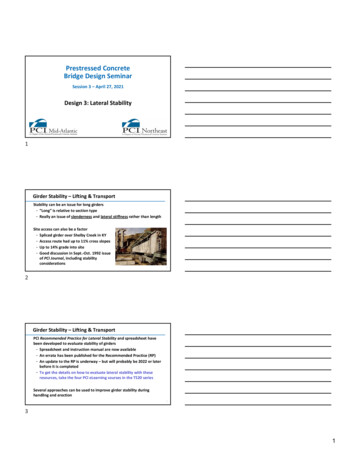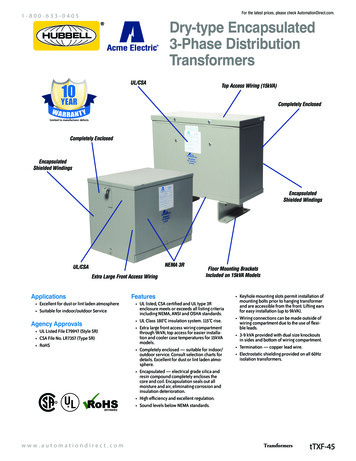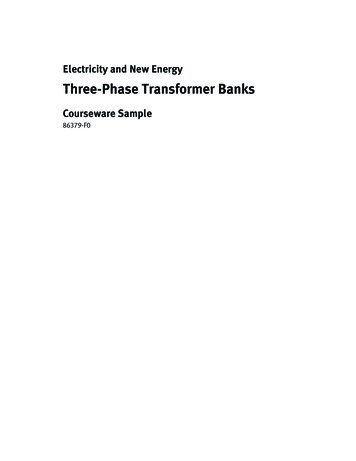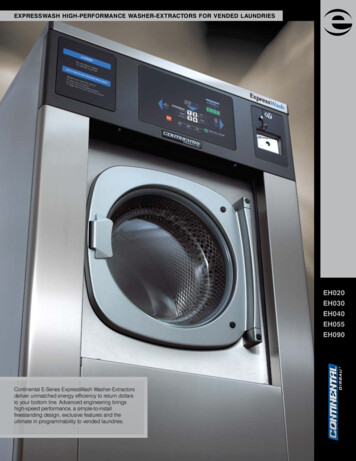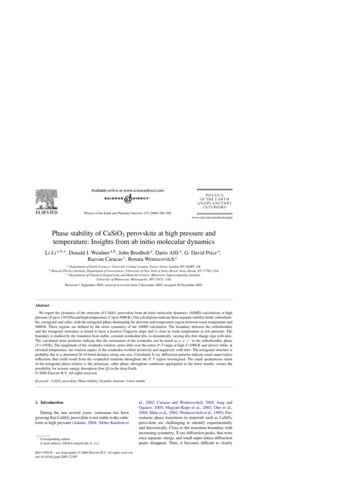
Transcription
Physics of the Earth and Planetary Interiors 155 (2006) 260–268Phase stability of CaSiO3 perovskite at high pressure andtemperature: Insights from ab initio molecular dynamicsLi Li a,b, , Donald J. Weidner a,b , John Brodholt a , Dario Alfè a , G. David Price a ,Razvan Caracas c , Renata Wentzcovitch cba Department of Earth Sciences, University College London, Gower Street, London WC1E6BT, UKMineral Physics Institute, Department of Geosciences, University of New York at Stony Brook, Stony Brook, NY 11790, USAc Department of Chemical Engineering and Material Science, Minnesota Supercomputing Institute,University of Minnesota, Minneapolis, MN 55455, USAReceived 7 September 2005; received in revised form 2 December 2005; accepted 20 December 2005AbstractWe report the dynamics of the structure of CaSiO3 perovskite from ab initio molecular dynamics (AIMD) calculations at highpressure (P up to 130 GPa) and high temperature (T up to 5000 K). Our calculations indicate three separate stability fields: orthorhombic, tetragonal and cubic, with the tetragonal phase dominating the pressure and temperature region between room temperature and4000 K. These regions are defined by the stress symmetry of the AIMD calculation. The boundary between the orthorhombicand the tetragonal structures is found to have a positive Clapyron slope and is close to room temperature at low pressure. Theboundary is marked by the transition from stable, constant octahedral tilts, to dynamically varying tilts that change sign with time.The calculated atom positions indicate that the orientation of the octahedra can be noted as a a c in the orthorhombic phase(T 150 K). The magnitude of the octahedra rotation varies little over the entire P–T range at high T (1000 K and above) while, atelevated temperature, the rotation angles of the octahedra oscillate positively and negatively with time. The tetragonal structure isprobably due to a shortened Si O bond distance along one axis. Calculated X-ray diffraction patterns indicate small super-latticereflections that could result from the octahedral rotations throughout the P, T region investigated. The small spontaneous strainof the tetragonal phase relative to the aristotype, cubic phase, throughout conditions appropriate to the lower mantle, creates thepossibility for seismic energy absorption (low Q) in the deep Earth. 2006 Elsevier B.V. All rights reserved.Keywords: CaSiO3 perovskite; Phase stability; Dynamic structure; Lower mantle1. IntroductionDuring the last several years, consensus has beengrowing that CaSiO3 perovskite is not stable in the cubicform at high pressure (Adams, 2004; Akber-Knutson et Corresponding author.E-mail address: lilli@ic.sunysb.edu (L. Li).0031-9201/ – see front matter 2006 Elsevier B.V. All rights reserved.doi:10.1016/j.pepi.2005.12.007al., 2002; Caracas and Wentzcovitch, 2005; Jung andOganov, 2005; Magyari-Kope et al., 2002; Ono et al.,2004; Shim et al., 2002; Wentzcovitch et al., 1995). Ferroelastic phase transitions in materials such as CaSiO3perovskite are challenging to identify experimentallyand theoretically. Close to the transition boundary withincreasing symmetry, X-ray diffraction peaks, that wereonce separate, merge, and small super-lattice diffractionpeaks disappear. Thus, it becomes difficult to clearly
L. Li et al. / Physics of the Earth and Planetary Interiors 155 (2006) 260–268define the phase of a solid close to the boundary withsuch tools. Theoretically, the different polymorphs havevery similar energies, making it difficult to define thestable phase. Recent progresses in both the theoreticaland experimental studies of CaSiO3 perovskite are dueto the improvements in the methods used.While the different polymorphs of perovskite arecrystallographically very similar, they can have quite different properties (Carpenter et al., 2000). Furthermore,being close to the phase boundary can introduce new phenomena, such as soft vibrational modes, which can causesome shear velocity to become very low or even to vanish(Carpenter et al., 2000), or high attenuation of acousticwaves as domain wall boundaries become very mobile(Harrison et al., 2003). Both of these effects could produce significant signals on the seismic record. MgSiO3 ,perovskite has been shown to be far from a ferroelastic phase transformation by both theory and experiments(Karki et al., 2001; Oganov et al., 2001; Shim et al.,2001; Stixrude and Cohen, 1993; Wentzcovitch et al.,1995; Wolf and Jeanloz, 1985). Thus, the primary candidate for a deep earth ferroelastic phase transition isCaSiO3 perovskite. Here we present the results of an abinitio high temperature study of the stable distortions ofthis phase using molecular dynamics. We conclude thatthe cubic phase is not entirely stabilized even at temperatures of the Earth’s lower mantle. While we find thatthe elastic moduli are not appreciably softened (Li et al.,2005), the attenuation due to the ferroelastic character ofCaSiO3 perovskite may make this phase very distinctivein its seismic signature.261The unit cell of the perovskite for most of thesecalculations was oriented with one axis parallel to thepseudo-cubic axis and the other two axes rotated 45 from the pseudo-cubicaxes. Cell lengths of the three axes thus become 2a, 2a, a, where a is the cubic celllength. The molecular dynamics box is then 2 2 2of these unit cells containing 80 atoms. This orientationwas chosen to allow maximal freedom of the unit cellto distort from its cubic form to Pbnm, the stable formof the analogue, MgSiO3 perovskite. The stresses for acubic box were calculated over at least 2 ps of simulation.Tests showed that longer simulation has little effect onthe calculated results. Error analysis for the stresses areperformed following the algorithm described by Allenand Tildesley (1997). The first criterion for being a stable cubic phase is whether the stresses on the 80 atom boxis hydrostatic or not. If not, then the dimensions of thecell were modified until the stress became hydrostatic.3. Phase stability2. Computational methodFig. 1 illustrates the phase diagram for CaSiO3 perovskite based on the stress analysis of the 80 atom boxwhose initial dimensions were 2 2a, 2 2a, 2a. Thelabels of cubic, tetragonal, and orthorhombic are simplybased on the cell dimension of the hydrostatic equilibrated structure. The principle stresses for the cubic boxare illustrated in Fig. 2 as a function of pressure and temperature. In this setting, the shear stresses are all zero forall of the phases. A systematic stress difference of magnitude between 1 and 5 GPa of the c axis relative to the aand b axes persists over a wide pressure and temperaturerange. When the differences fall beneath the uncertaintyAb initio molecular dynamics (AIMD) simulationswere performed to calculate the state properties ofCaSiO3 perovskite using VASP code (Kresse andFurthmüller, 1996a,b). The exchange-correlation functional Exc is the PW91 form of the generalized gradient approximation (GGA) (Perdew et al., 1992; Wangand Perdew, 1991). We use projector-augmented-wave(PAW) implementation of density functional theory(DFT) and the implementation of an efficient extrapolation for the charge density (Alfè, 1999; Blöchl, 1994;Kresse and Joubert, 1999). All calculations were performed using an 80-atom super-cell. A plane-wave cutoff energy 500 eV was shown to be sufficient for thestructures to converge. Γ point was used for samplingthe Brillouin zone. The time step used in the dynamicalsimulation was 1 fs. The core radii are 2.3 a.u. for Ca(core configuration 1s2 2s2 2p6 ), 1.9 a.u. for Si (1s2 2s22p6 ) and 1.52 a.u. for O (1s2 ).Fig. 1. Calculated phase diagram of CaSiO3 perovskite. Below thesolid line, an orthorhombic phase is stable; above the dashed line, acubic phase is stable. The tetragonal phase that dominates the plot istetragonal on an instantaneous time scale (1 fs), but probably “cubic”when averaged over time (1 ps).
262L. Li et al. / Physics of the Earth and Planetary Interiors 155 (2006) 260–268Table 1Unit cell dimensions for the tetragonal phaseFig. 2. Calculated stress σ 11 , σ 22 and σ 33 vs. temperature (T) for cells with a 2 2d0 , b 2 2d0 and c 2d0 at three volumes (V)(d0 is the size of a cubic unit cell) and T 0–5000 K. σ 12 , σ 23 andσ 13 are close to zero in all cases, thus only shown in V 45.53 Å3 .In general, σ 33 is lower than both σ 11 and σ 22 except V 45.54 Å3and T 5000 K. The difference between σ 11 and σ 22 varies with T. AtV 45.53 Å3 , calculations were performed at 0, 150, 300, 500, 750 Kand higher. (σ 11 σ 22 )/σ 11 is about 10% when T 500K. At T 500K,σ 11 σ 22 within the resolution. At V 35.80 Å3 , calculations wereperformed at 0, 150, 500, 750, 1000 K and higher. The differencebetween σ 11 and σ 22 is about 3% when T 1000 K. At T 1000 K,(σ 11 σ 22 )/σ 11 0.5%. AIMD calculations were performed to derivea cell in hydrostatic condition by optimising the cell parameters. Thehydrostatic cell parameters show the following relationship: a b c atT 1000 K for the cells with three V. These results suggest that CaSiO3perovskite experience a second-order phase transition from orthorhombic to tetragonal. At low pressure ( 10 GPa), this phase transitionoccurs between 300 and 500 K; at high pressure ( 120 GPa), this phasetransition occurs between 750 and 1000 K. A higher transition temperature at higher pressure for CaSiO3 perovskite indicates a exothermicphase boundary. Cubic structure was found only at V 45.53 Å3 andT 4000 K.P (GPa)T (K)a (Å)b (Å)c (Å)1 c/aV (Å3 035.8035.80level, as it does at the highest temperature for the largestvolume, then the phase is defined as cubic. Throughout the ‘tetragonal’ field, the non-hydrostatic stress is anorder of magnitude greater than the uncertainty arisingfrom the time-step to time-step variation. It thus appearsthat a tetragonal phase is stable over the major region ofthe Earth’s lower mantle.An orthorhombic phase (all principle stresses are different) is stable at lower temperature. A Clapyron slopeof about 5 K/GPa separates the orthorhombic phase fromthe tetragonal phase. At high pressure, the orthorhombicphase is the stable room temperature phase, while at lowpressure the tetragonal field covers room temperature.Table 1 gives the cell dimensions of the tetragonalphases as a function of P and T. These dimensions aredetermined by varying the cell shape until the calculatedstress is hydrostatic within the uncertainty of the calculation. The values are given relative to the pseudo-cubiccell for a primitive cell along with the axis ratios. Table 2gives similar values for the orthorhombic phase wherethe results are presented for the rotated coordinate system. The tetragonal phase is characterized by c a; thedistortion from cubic (1 c/a) span from 0.6% to 1.0%.The calculated distortions in the orthorhombic phase areabout 0.8% for (1 b/a) and 1.5% for (1 c/a). Our calculated results are in agreement with the experimentalresults of Shim et al. (2002) who used monochromaticX-rays at pressures between 20 and 50 GPa and roomtemperature after quenching from higher temperatures,find evidence for a tetragonal phase with c a with thedistortion in the range of 0.4–0.7%. The model for thetetragonal phase, as with the experimental observationsdoes not indicate a marked change in distortion withpressure. The consistency of the experiments and theory indicates that the tetragonal phase is the stable roompressure phase over this pressure range and, therefore,the orthorhombic phase is stable at lower temperatures.
L. Li et al. / Physics of the Earth and Planetary Interiors 155 (2006) 260–268263Table 2Unit cell dimensions for the orthorhombic phaseP (GPa)T (K)a (Å)b (Å)c (Å)1 a/b 1 a/ 2c 1 b/ 71959.31217.01806.81296.53360.0056 0.0081 0.0110 0.0079 0.0169 0.0189 0.0136 0.0088 0.0078In order to test whether or not the choice of box shapeaffects the stability of a tetragonal phase, we performedthe MD calculations on an 80 atom sample in the aristotype cubic coordinate system of 2a 2a 4a dimensionat 2000 K and 50 GPa (the center of the ‘tetragonal’field). Indeed, the time average stresses for the cubic boxwere hydrostatic. However, the time average of the differential stress, σ 3 σ 1 is 4 GPa, about the same valueas the time average differential stress deduced in therotated system. We conclude that on the femto-secondtime scale for this cubic oriented model, the structureis tetragonal. However, the dynamics associated withthe ferroelastic twinning has the effect of interchangingthe axes, and makes the time-averaged structure cubic.It seems therefore that the box shape has an influenceon the dynamics of the system. Both simulation orientations show that a tetragonal structure is stable ona short time scale, but the rotated coordinate systemdynamically stabilizes the tetragonal phase. Which boxorientation provides the best approximation to an infinite sized sample is difficult to deduce, but we take theview that both orientations indicate the presence of atetragonal symmetry, at least on some time scale, andthe rotated coordinate system stabilizes this structure.Thus, to examine the properties of this tetragonal phasefurther, we use the rotated coordinate system for the following studies.bond, treating each plane of octahedra separately. Thisgives 16 independent displacements to define each of thesix rotation angles. A sample of the time dependence ofthese angles is illustrated in Fig. 4 for several temperatures at the largest volume of this study. At the lowesttemperature, 150 K, two adjacent planes along the x axisare rotated by about 4 , but in opposite directions. Theβ angle is also about 4 and is also out of phase for twoparallel planes. The γ angle has the same phase for bothplanes of octahedra along the c axis, with a magnitude ofabout 2 . In Glazer’s (1972) notation, this would be considered an a a c distortion, which yields the Pbmnspace group, consistent with the orthorhombic dimensions for the hydrostatically stressed cell (a b c).By 300 K, a low frequency vibration allows a coupleof short reversals during the 2 ps of time for α, duringwhich β remains stable while γ is now averaging closerto a value of zero. This would be classified as a a co ,distortion or a Imcm space group. By 500K, the longperiod reversals of the α and β angles, with a period ofabout 1 ps become dominant, but the normal oscillationsof about 150 ps of the octahedra persists throughout thewhole temperature range of 150–4000 K illustrated in4. Phase characterizationThe multiple polymorphs of perovskite are derivedfrom the cubic structure, illustrated in Fig. 3, by a combination of rotations and distortions of the octahedra(Glazer, 1972, 1975). Following Glazer’s (1972) notation, we define rotations of the octahedra about the cubicaxes a, b, c as α, β, γ. Allowing alternating planes of octahedra to rotate either in phase or out of phase, ridgedbody rotations of the Si-bearing octahedra can generate 23 distinct crystal structures whose symmetry varyfrom monoclinic to cubic. The rotations shorten the celledge lengths as a 2dSi O cos(β)cos(γ), where dSi O isthe oxygen–silicon distance. We calculate the rotationangles of the structure at each time step by analyzing thedisplacement of the oxygen perpendicular to the Si OFig. 3. The perovskite crystal structure. This image represents the 80atoms that were included in the molecular dynamics calculations. Thecalcium cation is represented by the sphere, oxygen is located at thecorners of the octahedra and silicon is inside the octraheron. Periodicboundary conditions extend the structure in all directions.
264L. Li et al. / Physics of the Earth and Planetary Interiors 155 (2006) 260–268Fig. 4. Calculated octahedral tilt angles (α, β and γ, from left to right) as a function of time at several representative temperatures (150, 300, 500and 750 K, from top to bottom) for a cell volume of 45.53 Å3 . The solid and broken lines represent the tilts of adjacent planes of octahedra.this figure. By 500 K the γ angle is oscillating about zerowith no apparent phase relationship between the two setsof octahedra. Thus, in the region where a orthorhombicphase transforms to a tetragonal phase (a b c), theoctahedra transform from stable a a c configurationto one where the octahedra are oscillating ( ) to ( ), witha gradual loss of coherence between the adjacent planeswith increasing temperature. Fig. 5 illustrates the Si OFig. 5. Si O bond lengths as a function of time for a cell volume of 45.53 Å3 . The Si O bond lengths variations increase with temperature whilethe oscillation period remains fairly constant at about 80 fs.
L. Li et al. / Physics of the Earth and Planetary Interiors 155 (2006) 260–268Fig. 6. The variance reduction of the oxygen displacement perpendicular to the Si O bond due to octahedral tilting. This value decreaseswith temperature but is reasonably independent of cell volume. Thedecrease with temperature indicates increasing displacements that distort rather than tilt the octahedra.bond length as a function of time for a two typical temperatures. The Si O bond lengths change significantlywith temperature, but the frequency is much higher thanthat of the octahedral rotation, indicating that the calculated octahedral angles are not contaminated with theSi O interaction. In order to confirm that we see signalin the calculated octahedral rotation, we calculate thevariance reduction of the oxygen displacements that areused to calculate the rotations. These are plotted in Fig. 6as a function of temperature. At low temperature, thereis about a 90% reduction in the variance and this reducesto about 30% at the highest temperatures. This suggeststhat about 70% of the oxygen displacement perpendicular to the Si O bond distorts the octahedra while 30%is associated with a synchronized rotation of all of theoctahedra in any one plane, certainly a strong signal atsuch high temperatures.Throughout the broad temperature range, the magnitude of the octahedral rotation and the period remainquite constant. The phase transformation is accompanied by a longer period oscillation – a soft mode – thathas sufficient magnitude as to change the sign of therotation. This mode disappears as the fundamental oscillation of the octahedra has sufficient amplitude to crossthe zero line. A value of the octahedral rotation whichaverages over the six rotation angles and averages overtime is illustrated as a function of temperature in Fig. 7.As these rotations indicated no dependence on pressure,we give only one value for each temperature. Indeed,the angles do not vary with temperature either. Theyremain slightly under four degrees from 150 to 5000 K.That the structure undergoes phase transformations withincreasing temperature is more a reflection of the spaceand time average of the structure, but not the localstructure.265Fig. 7. Octahedral tilt angles as a function of temperature. The opensymbols represent the time average of the tilt angle calculated fromthe octahedral tilts of each frame spaced 1 ps apart and averaged overat least 1000 frames. The closed symbols represent the octahedral tiltsthat are needed to rationalize the ratio of the average Si O bond lengthand the cell edge length. The difference between the two curves mustbe due to O Si O angles that distort the octahedron rather than tilt it.Fig. 8 illustrates the average Si O bond length asa function of temperature at constant volume. A zeroslope of these lines would be consistent with the quasiharmonic approximation. While all of the points tendto indicate a slight increase of the Si O distance withtemperature, the greatest departure from constancy isat the lowest pressure and highest temperature, wherethe anharmonic contributions are expected to becomesignificant. The 4000 and 5000 K points at the largestvolume are the conditions where the hydrostatic cell wascubic within the uncertainty of the calculation, whichmay also be related to the change in character of theSi O bond here. If the cell volume remains constantand the average Si O bond increases with temperature,then the Si O bond-angle distortion from the perfectcubic structure must increase with temperature. Fig. 7,Fig. 8. The time averaged Si O bond lengths as a function of temperature. Each set of data points correspond to a fixed volume. Thedeparture from a fixed value indicates anharmonic behavior and anincrease in value requires increased O Si O angles.
266L. Li et al. / Physics of the Earth and Planetary Interiors 155 (2006) 260–268depicts this angle as a function of temperature. Here wepresent the octahedral tilts that are needed to rationalizethe ratio of the average Si O bond length and the celledge length. As we see, the actual octahedral rotationremains constant with temperature while the distortionangle induced by increasing the Si O distance is nearlyequal to the octahedral rotation angle at low temperature,but nearly triples by 5000 K. The difference betweenthese two angles must be a distortion of the octahedraand is consistent with the observation that the octahedral rotation accounts for only about 1/3 of the angulardistortion at these high temperatures.We can summarize the roles of pressure and temperature on the sample volume as follows. Changes in pressure shorten the Si O bond but have little effect neitheron the octahedral rotations nor on the octahedral distortions. Temperature increases at constant volume causesthe average Si O bond to increase slightly. This increaseis accommodated entirely by distortions of the octahedra with no increase in the rotation of the octahedra.This would mean that at constant pressure, temperatureincreases volume mostly by increasing the Si O bond.In fact, the Si O bond increases slightly more than thevolume, with compensation coming from the distortionof the octahedra.Once the rotation angles begin to change sign, thenthe average structure should become cubic unless theoctahedra themselves are distorted. Indeed, the Si Obond length is shorter in the c direction than in the a–bplane. Fig. 9 illustrates the average Si O bond lengthratio between that parallel to the c direction and that per-Fig. 9. The c/a ratio of the tetragonal cell and of the octahedra. The timeaveraged Si O bond lengths parallel to the c axis are compared withthose perpendicular to the c axis. This ratio is then in turn comparedto the tetragonal distortion that is necessary to produce a hydrostaticstress field. The values represent an average for the three volumes thathave been studied here, as there is no apparent volume dependence ofthis value. The similarity of these values suggests that the principlecause of the tetragonal distortion is the distortion of the octahedra.pendicular to it. This is compared with the tetragonaldistortion for the hydrostatic cell, namely the c/a ratio ofthe unit cell. The similarity of these curves implies thatthe tetragonal distortion is the result of the anisotropyof the Si O bond length in the octahedron. Perhaps, theorthorhombic setting of the molecular dynamics calculation helped organize the short Si O bonds, yieldingthe tetragonal structure in this setting. We expect thatindeed, the local structure will be tetragonal, but the shortaxis might be averaged over time to yield a cubic structure, in much the same manner that the octahedral tiltsare averaged in time. Measurements, that are sensitiveto local structures (hundreds of atoms) and short timespans, will see a tetragonal or perhaps an orthorhombicstructure. Those measurements that average over largevolumes or times longer than a pico-second, will sensea cubic structure. In a companion paper (Li et al., 2005),we present the single crystal elastic moduli for CaSiO3perovskite at these different conditions for all of thesestructures. We find that, within computational error, thesymmetry of the elasticity tensor is consistent with cubiceven with the stabilized tetragonal structure. Thus, thematerial may be close enough to a cubic structure thatmany of the physical properties will assume a pseudocubic character.5. Diffraction implicationsWe calculate the expected X-ray diffraction pattern bydetermining the structure factor for each femto-secondtime step, then by adding together the patterns of over1000 steps. These integrated spectra are calculated foreach temperature for the hydrostatic structure. The calculated X-ray diffraction patterns for the largest volume(lowest pressure) system are representative of all of thecalculations and are illustrated in Fig. 10. The peaks areidentified referenced to the cubic cell. All of the mainpeaks, represented in the main part of the figure areappropriate for the Pm3̄m cubic structure. Indeed, smallamounts of peak splitting appropriate to the departureof the cell dimensions from cubic are present. Not all ofthese peak splittings are captured in the figure owing tothe small amount of splitting compared to the samplinginterval in the x axis. The inset expands the region aroundthe (1 1 1) diffraction peak. Here diffraction peaks in thePbnm setting are located. These super-lattice diffractionpeaks disappear in the cubic structure and are relatedto the tilting of the octahedra. The calculated peaks arepresent for the structures studied here, but they are quitesmall. There exists a possibility that longer time calculations may find these peaks becoming even smaller. Theyare likely to be very difficult to detect experimentally, yet
L. Li et al. / Physics of the Earth and Planetary Interiors 155 (2006) 260–268267Fig. 10. Structure factor as a function of wave number for calculated CaSiO3 perovskite structures at several temperatures. Structure factors arecalculated for each frame separated 1 fs in time including 1000 frames. Hydrostatic conditions for the equilibrated structure with a cell volume of45.53 Å3 define the model. The 150 K cell is orthorhombic; the 1000–4000 K cells are tetragonal; the 5000 K cell is cubic. Peak indices in the mainfigure are referenced to the aristotype, cubic, Pm3̄m space group. The inset figure is an enlargement of the 4000 K diffraction pattern with peakindices referenced to the Pbnm space group indicating supper-lattice reflections. This section is representative of the other diffraction patterns.they betray the fact of the departure of the atom positionsfrom those of the cubic symmetry. The low intensity ofthese super-lattice reflections explain why Shim et al.(2002) only see the splitting of the cubic peaks and noclear evidence of super-lattice reflections. Indeed, theirresults (such as the c/a ratio) are in excellent agreementwith this study.6. ConclusionsAn AIMD calculation on CaSiO3 perovskite at highpressure and high temperature has allowed us to investigate the dynamics of the phase stability of CaSiO3perovskite by analyzing the equilibrated stresses andatom positions as a function of time at the femto-secondtime scale. We find that the octahedral tilts remain significant with little variation in magnitude to the highesttemperatures, where the structure may be either tetragonal or cubic on some time scales. This observationgoes counter to the model in which the phase transitionsare accomplished through the vanishing of the octahedral tilts. Thermal expansion is accomplished purely bySi O bond length increases. Similarly, compression isaccomplished by Si O bond shortening. The distortionof the octahedra accounts for the tetragonal distortionof the cubic phase at high temperature. Calculated X-raydiffraction patterns indicate that the tetragonal distortionis mostly observed through splitting of the cubic diffraction peaks while super-lattice reflections of orthorhombic symmetry are present with small intensities.A stable tetragonal structure for CaSiO3 perovskitein the Earth’s lower mantle can be important in determining Q of the region. CaSiO3 perovskite can be thesource of acoustic absorption due to its small ferroelaticstrain, for which domain-wall motion induced by acoustic stress absorbs acoustic energy (Harrison et al., 2003).This issue awaits further experimental exploration.AcknowledgementsThis work is support by NERC (Grant Nos.NER/T/S/2001/00855; NER/O/S/2001/01227), andcomputer facilities provided by NERC at UniversityCollege London, and the High Performance ComputingFacilities of the University of Manchester (CSAR) andthe Daresbury Laboratory (HPCx). DJW acknowledgesthe Leverhulme Trust for support through the visitingProfessor program. DJW and LL acknowledge NSF
268L. Li et al. / Physics of the Earth and Planetary Interiors 155 (2006) 260–268EAR-9909266, EAR0135551, EAR0135550. MPIpublication 360. R. Wentzcovitch acknowlege NSFEAR-0135533 and ITR-0428774 (VLab).ReferencesAdams, D., 2004. Molecular Dynamics Simulations of Cubic CaSiO3perovskite: an Ab Initio Study. In: Proceedings of the CECAMWorkshop on “First-Principles Simulations: Perspectives and Challenges in Mineral Sciences”, Berichte aus Arbeitskreisen der DGK,Nr. 14, German Crystallographic Society, pp. 79–82.Akber-Knutson, S., Bukowinski, M.S.T., Matas, J., 2002. On the structure and compressibility of CaSiO3 perovskte. Geophys. Res. Lett.29 (3), 1034.Alfè, D., 1999. Ab-initio molecular dynamics, a simple algorithm forcharge extrapolation. Comput. Phys. Commun. 118, 31–33.Allen, M.P., Tildesley, D.J., 1997. Computer Simulation of Liquids.Oxford Un
Ab initio molecular dynamics (AIMD) simulations were performed to calculate the state properties of CaSiO3 perovskite using VASP code (Kresse and Furthmuller, 1996a,b ). The exchange-correlation func-tional Exc is the PW91 form of the generalized gradi-ent approximation (GGA) (Perdew et al., 1992; Wang and Perdew, 1991). We use projector-augmented-wave (PAW) implementation of density .
